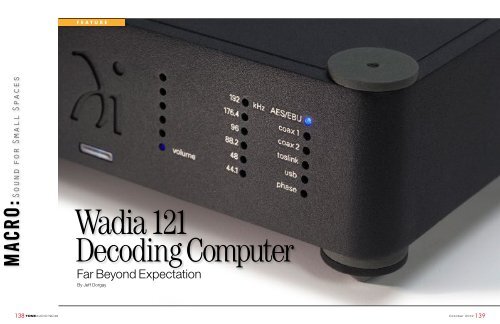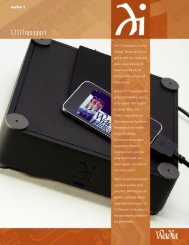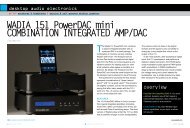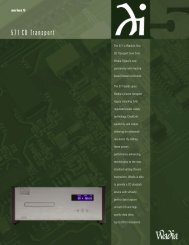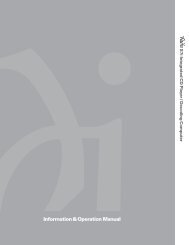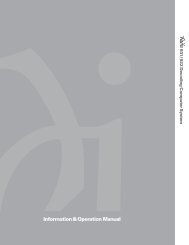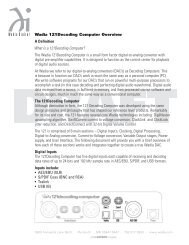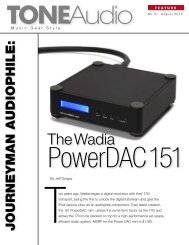Tone Audio N. 49 Wadia 121 Decoding Computer. Far Beyond ...
Tone Audio N. 49 Wadia 121 Decoding Computer. Far Beyond ...
Tone Audio N. 49 Wadia 121 Decoding Computer. Far Beyond ...
Create successful ePaper yourself
Turn your PDF publications into a flip-book with our unique Google optimized e-Paper software.
FEATURE<br />
MACRO: Sound for Small Spaces<br />
<strong>Wadia</strong> <strong>121</strong><br />
<strong>Decoding</strong> <strong>Computer</strong><br />
<strong>Far</strong> <strong>Beyond</strong> Expectation<br />
By Jeff Dorgay<br />
138 TONE AUDIO NO.<strong>49</strong><br />
October 2012 139
MACRO: Sound for Small Spaces<br />
WF EATURE<br />
Much like phonostages, you can<br />
purchase an outboard DAC for a couple<br />
hundred dollars and it’s a great way to<br />
embrace computer audio. Outboard DACs<br />
can also serve as an upgrade to a budget<br />
CD transport. Jumping to the $500 level<br />
brings more musicality and the ability to<br />
play high-res files, but going to the next<br />
level (the aforementioned $1,000-to-<br />
$1,500 range) is very exciting and, in the<br />
opinion of this reviewer, where the game<br />
gets seriously intriguing. Combining a<br />
computer source and a great $1,500 DAC<br />
with your choice of high-performance<br />
playback software (like Pure Music, Amarra<br />
or one of the other current favorites) puts<br />
you in close proximity to what would have<br />
cost $10,000 two years ago.<br />
Having used <strong>Wadia</strong> gear as a personal<br />
reference for years, I was excited to hear<br />
the company’s new S7i digital player during<br />
a recent visit to Sumiko’s sound room in<br />
Berkeley, California. Immersed in the sound<br />
of the $200,000-per-pair “The Sonus faber”<br />
speakers and two towers of six REL G-1<br />
subwoofers, driven by Pass Labs monoblocks,<br />
I felt in familiar territory. Yet, when I<br />
ith a number of stratospherically priced DACs on the market,<br />
it’s exciting to see DACs priced between $1,000 and $1,500<br />
offering so much performance. Reminiscent of the horsepower<br />
wars of the 1960s, it seems that every time a new standard<br />
of DAC performance is reached the bar is raised even higher. This<br />
time, <strong>Wadia</strong>—a company known for decades for its innovations in the realm of<br />
digital audio and, more recently, for its game-changing 170i iPod dock—delivers<br />
world-class sound at a very affordable price tag with its new <strong>121</strong> <strong>Decoding</strong> <strong>Computer</strong>.<br />
commented on how great the S7i sounded,<br />
I was instantly corrected. “That’s the new<br />
<strong>121</strong>,” a Sumiko representative informed me.<br />
So, in the context of a major six-figure system,<br />
the <strong>121</strong> playing 16-bit/44.1-kHz files via<br />
a computer sounded damn good.<br />
Imagine an S7i with no disc drawer,<br />
shrunk down to Barbie-Dream-House size.<br />
That’s the <strong>121</strong>—in general. It does use an<br />
external wall-wart supply, but that’s the only<br />
place <strong>Wadia</strong> really scrimped on the design.<br />
I’m sure making a super-high-zoot external<br />
supply would wring more performance out<br />
of the <strong>121</strong>, but then it would probably cost<br />
twice as much. (Mod-crazed audiophiles<br />
take note: Sumiko’s John Paul Lizars made<br />
it very clear to me that the series 1 <strong>Wadia</strong><br />
products would not be receiving upgraded<br />
external power supplies.)<br />
Expensive power supply or not, the <strong>121</strong><br />
is a serious DAC—or, as <strong>Wadia</strong> calls it, a<br />
digital decoding computer—which quickly<br />
becomes apparent when perusing its front<br />
and back panels. Rather than work with the<br />
same chipsets used in many other DACs,<br />
the <strong>121</strong> uses <strong>Wadia</strong>’s patented DigiMaster<br />
circuitry to upsample the incoming digital<br />
data to a 32-bit, 1.40-MHz bitstream.<br />
All inputs accommodate up to<br />
24-bit/192-kHz data and the USB<br />
input is asynchronous.<br />
<strong>Wadia</strong> also built a headphone<br />
amplifier into the <strong>121</strong>,<br />
with a 1/4-inch jack on the front<br />
panel. Running the gamut of<br />
headphones at my disposal from<br />
Grado, AKG, Sennheiser and Audeze<br />
proved enjoyable. The <strong>121</strong><br />
easily passes muster as a firstrate<br />
headphone amplifier. It also<br />
makes a perfect system for playing<br />
music from portable devices<br />
when paired with <strong>Wadia</strong>’s 170i or<br />
171i iPod dock. The <strong>121</strong>’s small<br />
footprint makes it an easy fit on<br />
a desktop next to your computer<br />
or on a nightstand for after hours<br />
listening.<br />
But what really separates the<br />
<strong>121</strong> from the rest of the comparably<br />
priced herd is its 32-bit digital<br />
volume control, making this a true<br />
digital preamplifier, not just a DAC<br />
with an attenuator slapped on the<br />
end of the output stage. <strong>Wadia</strong><br />
includes a full-function remote to<br />
complete the package.<br />
The <strong>121</strong> is a perfect example<br />
of the dividends reaped when<br />
a company building top-shelf<br />
products applies its expertise to<br />
something at this level. “We incorporated<br />
as much functionality<br />
as we could into the <strong>121</strong>,” notes<br />
<strong>Wadia</strong> CEO John Schaffer. “We<br />
didn’t want to just put a few DAC<br />
chips on the board and slap a<br />
<strong>Wadia</strong> badge on the front.”<br />
Back at the Mothership<br />
It’s tough to argue with the performance<br />
heard at Sumiko, as<br />
the system was one of the best<br />
I’ve heard, but it’s always good<br />
to audition gear in familiar surroundings.<br />
Plugged into my main<br />
reference system, comparing it<br />
directly to the <strong>Wadia</strong> 381i that I’ve<br />
owned for some time now, reveals<br />
the difference between the<br />
big box and the <strong>121</strong>.<br />
While it is unfair to compare<br />
the <strong>121</strong> to the $10K 381i, it’s fascinating<br />
to witness how much<br />
performance <strong>Wadia</strong> has been<br />
able to squeeze into this diminutive<br />
box, which is the exact same<br />
size as the 170i and 171i iPod<br />
docks. (continued)<br />
140 TONE AUDIO NO.<strong>49</strong><br />
October 2012 141
MACRO: Sound for Small Spaces<br />
When listening closely to the finger<br />
snaps in Giant Giant Sand’s “Ready or<br />
Not” (from the Tucson album) it is clear<br />
that the 381i delivers greater amounts of<br />
air and a longer-lasting decay, but the<br />
<strong>121</strong> handles the tonality amazingly well,<br />
while also presenting a big soundstage.<br />
When listening casually to less-thanstellar<br />
program material, and not directly<br />
in the sweet spot, it’s easy to confuse<br />
the <strong>121</strong> for something much more expensive.<br />
The <strong>121</strong> validates itself instantly<br />
when listening to how it delivers classical<br />
or acoustic music. Spinning Itzhak<br />
Perlman’s Live in the Fiddler’s House<br />
instantly reveals this DAC’s ability to<br />
convincingly render the violin. You can<br />
hear Perlman gently fingering the violin,<br />
with way more texture than you would<br />
expect at this price point and with<br />
ample air and decay. It’s easy to forget<br />
what you are missing until switching to<br />
the 381i. Yet, once switching back from<br />
the big-bucks DAC, the <strong>121</strong> continues<br />
to satisfy. And this is in the context of a<br />
142 TONE AUDIO NO.<strong>49</strong> FEATURE<br />
six-figure system, made up of all <strong>Audio</strong><br />
Research reference components.<br />
Placing the <strong>121</strong> in a system comprised<br />
of appropriately priced components—a<br />
PrimaLuna ProLogue Premium<br />
integrated amplifier and a pair of<br />
Vienna Acoustics Mozart speakers—is<br />
the right move. High-resolution digital<br />
files via a MacBook Air and Amarra<br />
software meet or exceed the musicality<br />
delivered by similarly priced turntables<br />
on hand.<br />
Blasting through a series of Blue<br />
Note XRCDs uncovers the same level<br />
of tonality: Drums have the proper<br />
amount of attack and the standup bass<br />
is weighty as well as defined. Wynton<br />
Kelly’s piano on Hank Mobley’s Soul<br />
Station floats in between the speakers,<br />
defined in it’s own space. It’s not so<br />
much the jump between the $10K DAC<br />
and the <strong>121</strong> that’s tough to swallow;<br />
it’s going back to a budget DAC after<br />
listening to the <strong>121</strong> that proves there’s<br />
just no music in the inexpensive stuff—<br />
no life, no air, etc. (continued)
FEATURE<br />
MACRO: Sound for Small Spaces<br />
Compare and Contrast<br />
The fairest comparisons for the <strong>121</strong><br />
are the amazing Rega DAC for $995<br />
and the Benchmark DAC1 USB at<br />
$1,195, especially given that the<br />
Benchmark can be used as a preamplifier.<br />
It features a volume control (albeit<br />
an analog volume control, where<br />
the <strong>121</strong>’s volume control operates in<br />
the digital domain) and headphone<br />
output. All three DACs can handle<br />
24-bit/192-kHz files. Although neither<br />
DAC adds romance or sterility to the<br />
sound, the Rega has a slightly warmer,<br />
more romantic sound, while the<br />
Benchmark is straight-up—it’s a great<br />
“just the facts, ma’am” kind of DAC.<br />
The <strong>121</strong> is closer to the Benchmark<br />
in tonality than the Rega, and<br />
each will appeal to a certain listener,<br />
but the <strong>Wadia</strong>’s edge is three-fold: It<br />
has the widest dynamic range, more<br />
low-level-detail retrieval and more<br />
weight in the LF spectrum than the<br />
other two—again, very similar to my<br />
381i. Having lived with <strong>Wadia</strong> digital<br />
players for many years, I can tell you<br />
that the big, dynamic, weighty feel<br />
that <strong>Wadia</strong> DACs produce is easily<br />
recognizable—which is also the case<br />
with the <strong>121</strong>.<br />
In terms of connectivity, the TOS-<br />
LINK input provided a slightly lessresolving<br />
presentation than the others,<br />
though it was still impressive and<br />
handy, should you have an older CD<br />
player that you would like to perk up.<br />
A vintage Sony ES player, only having<br />
a TOSLINK output, showed a marked<br />
improvement via the digital output<br />
and the <strong>121</strong>. Comparing USB, SPDIF<br />
and the AES/EBU connections via<br />
24/192 tracks, courtesy of the Aurender<br />
S10 server, revealed no anomalies<br />
between connections. This plethora<br />
of inputs makes it easy to switch<br />
between a transport, music server<br />
and digital files on an iPod/iPhone via<br />
a <strong>Wadia</strong> dock—which makes the <strong>121</strong><br />
perfect for the digital music lover with<br />
multiple sources.<br />
All You Need<br />
As great as the <strong>121</strong> performs in DAC<br />
mode, it’s the perfect hub for your<br />
music system. The DigiMaster volume<br />
control is effective and sonically transparent,<br />
all the way down to the lowest<br />
range. If there was some degradation<br />
of the original signal, we weren’t hearing<br />
it when I assembled the troops for<br />
a listening session.<br />
Thanks to TOSLINK, BNC, RCA,<br />
AES/EBU and an asynchronous USB<br />
input, there are no limitations to what<br />
the <strong>121</strong> can use as a source. We<br />
achieved excellent results using a<br />
Mac mini and MacBook Air, both<br />
running the latest version of Amarra;<br />
<strong>Wadia</strong>’s own 171i dock with an iPhone<br />
4S; and an old Pioneer CD player as<br />
a transport. The only thing keeping<br />
the <strong>121</strong> from appealing universally is<br />
its lack of a single analog input, which<br />
Benchmark incorporated into its<br />
highest-end version of the DAC1 PRE.<br />
Including a single analog input gives<br />
someone wanting to integrate analog<br />
into their system the option to use the<br />
<strong>121</strong> as a full-function preamplifier. For<br />
now, the <strong>121</strong> performs this task perfectly<br />
in an all-digital system.<br />
The <strong>121</strong> does have fully balanced<br />
analog outputs that handle long cable<br />
lengths admirably. The <strong>121</strong> has no<br />
problem with a 20-foot length of AVID<br />
SCT cable running from the rack to<br />
a bevy of awaiting power amplifiers.<br />
Even terminating the amplifier end of<br />
the cable, with a Cardas balancedto-RCA<br />
adaptor, was no problem.<br />
(continued)<br />
144 TONE AUDIO NO.<strong>49</strong><br />
October 2012 145
FEATURE<br />
We paired the <strong>121</strong> with at<br />
least a dozen amplifiers, including<br />
tube, solid-state and class-D,<br />
and they all work equally well in<br />
terms of frequency range and<br />
drive. However, this tube-lover<br />
favors the <strong>121</strong> with a number<br />
of low-power vacuum-tube<br />
amplifiers when using it strictly<br />
as a preamplifier. Personal bias<br />
admitted, a touch of tubeyness<br />
goes a long way with digital<br />
sources.<br />
Paired with the <strong>121</strong>, the<br />
updated Conrad-Johnson<br />
MV50 tube power amplifier<br />
and Dynaudio Confidence C1 II<br />
speakers make for a fantastic,<br />
all-digital system, with more<br />
than enough resolution to easily<br />
discern between Red Book and<br />
high-resolution digital files, and<br />
compare various Amarra settings.<br />
The <strong>121</strong> was no slouch driving<br />
the mighty Burmester 911 power<br />
amplifier directly; though, at this<br />
level, I did prefer having an active<br />
preamplifier in the signal path.<br />
The bottom line: With the <strong>121</strong>,<br />
we have a $1,295 DAC that can<br />
hang with some pretty expensive<br />
company.<br />
This is why we’ve determined<br />
that the <strong>Wadia</strong> <strong>121</strong> is more than<br />
worthy of one of our Exceptional<br />
Value Awards for 2012. Whether<br />
seeking a high performance<br />
DAC or a fully functioning digital<br />
preamplifier to build your system<br />
around, your search is over.<br />
The <strong>Wadia</strong> <strong>121</strong><br />
MSRP: $1,295<br />
www.wadia.com<br />
October 2012 147


